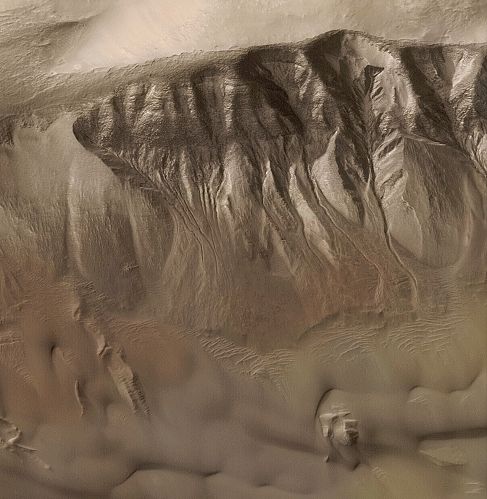Skip to comments.
Astronomy Picture of the Day 10-24-02
NASA ^
| 10-24-02
| Robert Nemiroff and Jerry Bonnell
Posted on 10/23/2002 10:37:44 PM PDT by petuniasevan
Astronomy Picture of the Day
Discover the cosmos! Each day a different image or photograph of our fascinating universe is featured, along with a brief explanation written by a professional astronomer.
2002 October 24

Gullies on Mars
Credit: Malin Space Science Systems, MGS, JPL, NASA
Explanation: The Gullies of Mars would probably not have been sensational enough for the title of a vintage Edgar Rice Burroughs story about the Red Planet. But it would get the attention of planetary scientists today. First identified in high resolution images of Mars recorded by the orbiting Mars Global Surveyor spacecraft, the gullies are interpreted as startling evidence that liquid water flowed across the martian surface in geologically recent times. Similar channels on Earth are formed by flowing water, but on Mars the temperature is normally too cold and the atmosphere too thin to sustain liquid water. Still, it is thought possible that water did burst out from underground layers and remain liquid long enough to erode the gullies, while alternative explanations suggest the erosion was produced by a flowing jumble of solid and gaseous carbon dioxide. Spanning a few kilometers along the wall of an impact crater this high resolution image from Mars Global Surveyor shows typical martian gullies near the top of the crater wall giving way to sand dunes toward the crater floor. Whitish frost is visible on near the top and on the dark sand dunes below. The muted colors were synthesized from wide angle image data.
TOPICS: Astronomy; Astronomy Picture of the Day; Science
KEYWORDS: areology; astronomy; discovery; erosion; exploration; geology; globalsurveyor; gullies; image; mars; photography; redplanet; spacecraft; surface; theory; water
Astronomy Fun Fact:Phobos, one of the moons of Mars, is so close to its parent planet that it could not be seen by an observer standing at either of Mars' poles. Phobos makes three complete orbits around Mars every day.
To: MozartLover; Joan912; NovemberCharlie; snowfox; Dawgsquat; viligantcitizen; theDentist; ...
To: petuniasevan
There is a sculpture of cartoon dog in the lower right corner.
To: Jeff Chandler
It seems to be balancing a block of cheese on its nose.
To: Jeff Chandler
Cosmic sense of humor.
To: petuniasevan; All
good morning bttt
6
posted on
10/24/2002 4:17:15 AM PDT
by
firewalk
To: petuniasevan
An excellent image of evidence of wind and water erosion on Mars. Thanks!
Would not a "slurry of CO2" ablate very rapidly from solid to gas in the thin Martian atmosphere? If so, there would be only a slight chance for channelized erosion of the soil and rock fragments on the surface of Mars, and thus reduce the probability that these channels were formed by CO2 flow.
7
posted on
10/24/2002 6:51:16 AM PDT
by
Graewoulf
To: Jeff Chandler
LOL! There's also Alfred Hitchcock's face carved out of one of the peaks in the upper right quad of the image.
(Actually, it all looks like a close-up of chocolate ice cream -- now I'm hungry... ;^)
8
posted on
10/24/2002 9:33:18 AM PDT
by
mikrofon
To: Graewoulf
I was thinking about that when I posted this APOD.
You said it better than I would have!
We can tell the difference between ice-based erosion and water-based erosion on Earth; why would Mars be much different?
To: petuniasevan
Either way, the two atmospheres can be re-created in a laboratory, as well as the two soils, and then when the CO2 is added at various temperatures the effects of erosion can be directly observed.
Do you know of any such comparative test in the published literature?
Disclaimer:
Opinions posted on Free Republic are those of the individual
posters and do not necessarily represent the opinion of Free Republic or its
management. All materials posted herein are protected by copyright law and the
exemption for fair use of copyrighted works.
FreeRepublic.com is powered by software copyright 2000-2008 John Robinson
